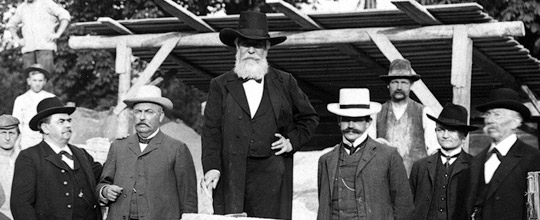The zoological-palaeontological collections
The eventful history of the zoological-palaeontological collections began in 1779 with the purchase of the “Walchsches Naturalienkabinett” (a cabinet of curiosities) by Duke Carl August of Sachsen-Weimar, which together with other pieces from the ducal cabinet of arts formed the basis of the “Herzogliches Museum” (Ducal Museum), later to become the “Museum mineralico-zoologicum Magniducale”. In 1839, the “Zoological Cabinet”, which was by now also being used for teaching purposes, comprised 2,073 specimens, including 39 mammals and 524 birds. Goethe had a significant influence on the museum and its collections, and the Phyletisches Museum still possesses fossils and whale bones that were acquired thanks to him – not to mention the fossilized bull skeleton that Bojanus used for his description of the Aurochs Bos primigenius in 1827.
In 1850, Oscar Schmidt initiated the separation of the mineralogical and zoological collections, turning the “Zoological Museum” into an independent institution whose future director Ernst Haeckel would found the Phyletisches Museum in 1907.
The collections were extended significantly under the directorship of Ernst Haeckel, who brought with him his own large collection of animals from the Red Sea, the Indian Ocean and Ceylon (Sri Lanka). Later, material collected by Richard Semon (Malayan Archipelago and Australia), Ludwig Plate (Ceylon) and Jürgen Harms (Java and Sumatra) followed. In addition, collections of insects, molluscs and fossils were purchased or donated to the museum. The material brought back from the expeditions, in particular, contains a number of type specimens.
As the Phyletisches Museum was built without a separate repository to house the scientific collections, only parts of the collections were kept in the museum building, with the majority of the specimens stored at the Institute of Zoology. The situation did not change until the exhibition halls of the museum were modernized between 1956 and 1963 under the directorship of Manfred Gersch. A separate repository, not open to the public, was set up on the top floor of the museum to house the extensive insect collections. A huge amount of material was acquired after 1969 with the absorption of large zoological-palaeontological collections from other institutes of Friedrich Schiller University. At this point, the scientific collections started being developed systematically. Since then much progress has been made, under the leadership of curator Dr. Dietrich von Knorre, in ordering the existing inventory, recording it scientifically, and making it available for research and teaching.



